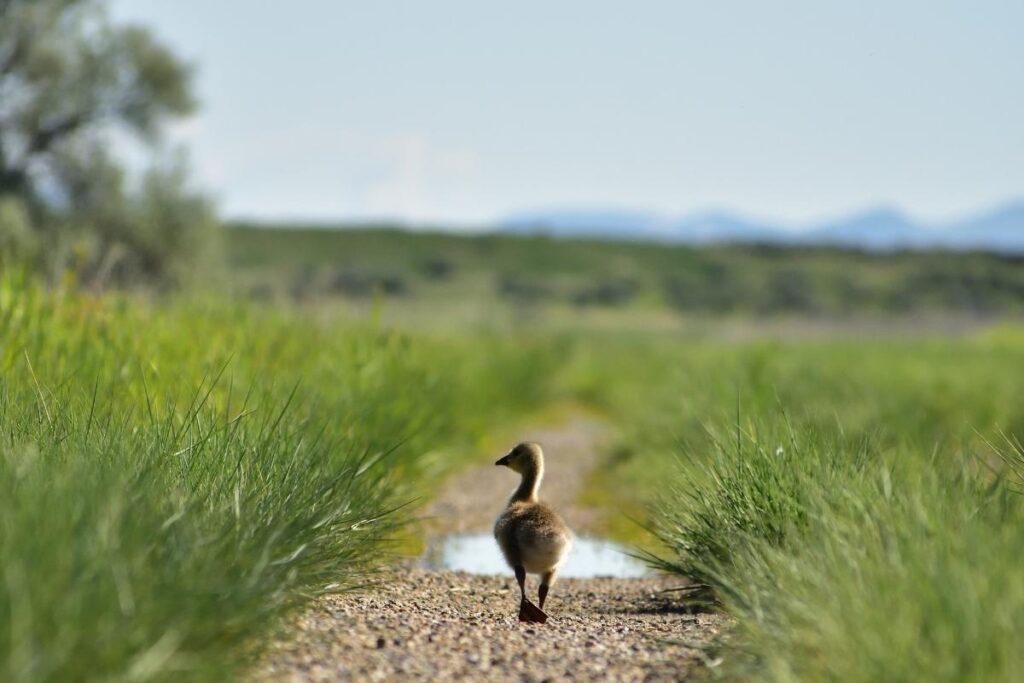
Living or visiting Idaho and wondering what bird you’re looking at? This article covers the most common birds of Idaho. Odds are high the bird you’re looking at is one of them. It will also inform you on how to identify them.
Birding in Idaho
An unspoiled landscape of mountains, lakes, and rivers makes Idaho a natural habit for birds. There are 2,000 miles of bird trails and many different birding hot spots.
Deer Flat National Refuge in southwest Idaho is especially important for migrating birds such as mallards and Canada Geese. Birders love watching the Western Grebes cavorting on Lake Powell. The Refuge has been declared a Globally Important Bird Area by the American Bird Conservancy.
Camas National Wildlife Refuge off Interstate 15 in southeast Idaho sees more than 50,000 ducks and 3,000 geese during the spring and fall migration, as well as the trumpeter swan, the largest waterfowl in the US. The marshes in the Refuge attract a variety of waterbirds, such as herons, egrets, and cranes, among others. Birders will spot hawks, owls, and Bald Eagles in the grasslands
Hagerman Wildlife Management Area in southcentral Idaho is the winter home to up to 40,000 ducks. A large number of Bald Eagles live here, as well, when the weather gets cold. Riley Pond is home to an abundance of waterfowl and shorebirds.
Snake River Birds of Prey National Conservation Area is where the Snake River flows for 81 miles through a huge canyon filled with cliffs. This area has the most nesting birds of prey in the country – maybe the world. Each spring sees the arrival of hawks, owls, falcons, and eagles preparing to mate and raise an avian family. The crevasses in the cliffs are ideal for aeries while the raptors hunt for food down in the canyon. It is a remote area, but a win for birders willing to rough the terrain. From the town of Kuna, there is an overlook at Dedication Point that is likely to reveal quite a few predator birds.
C.J. Strike Wildlife Management Area is 50 miles southeast of Boise. Thousands of waterfowl migrate here, including the Snow Goose, Tundra Swan, and Trumpeter Swan. Golden Eagles and Rough-legged Hawks can also be spotted in the winter.
Mud Lake Wildlife Management Area is the area surrounding Mud Lake in Jefferson County. The lake is surrounded by wetlands that are used by both water and shorebirds. There are camping sites for those who want to spend extra time here. Birders can check out the automated driving map for the Idaho Birding Trail.
Common Birds of Idaho
American Robin

American Robin can be found in most Idaho counties year-round. It is a large, puffy songbird with long legs and tail. They are dark gray with white tips on the wings and a white throat and rump. The underbelly is orange. They grow 7.9 to 11.0 inches in length and weigh 2.7 to 3.9 ounces with a wingspan between 12.2 to 15.8 inches. It is easy to catch sight of an American Robin in gardens, golf courses, and deciduous or pine forests. Insects and berries make up most of the American Robin’s diet.
Mourning Dove

Mourning Dove lives in Idaho throughout the year but is most easily spotted from April through September. They are light tan in color with gray wings. They grow 9.1 to 13.4 inches in length and weigh 3.0 to 6.0 ounces with a wingspan of 17.7 inches. They are known for their mournful cry and can be found in grasslands and fields. To attract mourning doves to the backyard, add some millet or sunflower seeds to the bird feeder.
Black-billed Magpie
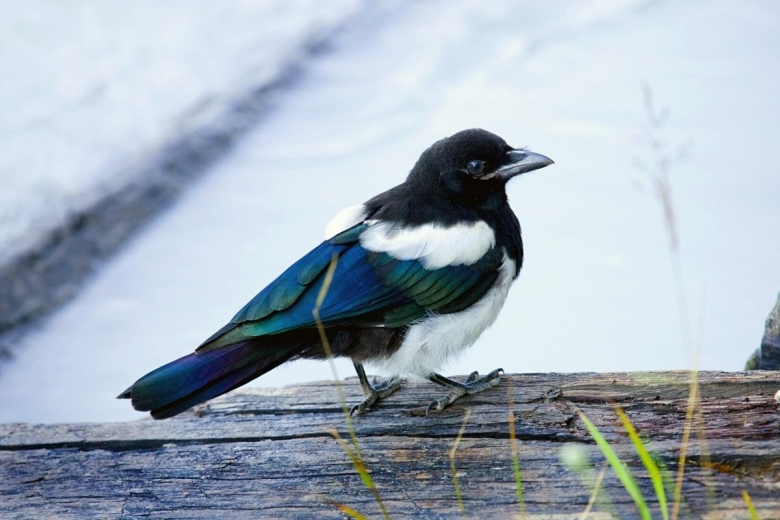
Black-billed Magpie lives in Idaho all year. They have iridescent black and blue wings with white tips when the wings are spread. Their tail and back are black, and they have a white belly and white stripes on the wings. They grow 17.7 to 23.6 inches in length and weigh 5.1 to 7.4 ounces with a wingspan between 22.1 and 24.0 inches. The Black-billed Magpie inhabits fields and places that have an abundance of food such as fruits, grains, and small animals.
Black-capped Chickadee
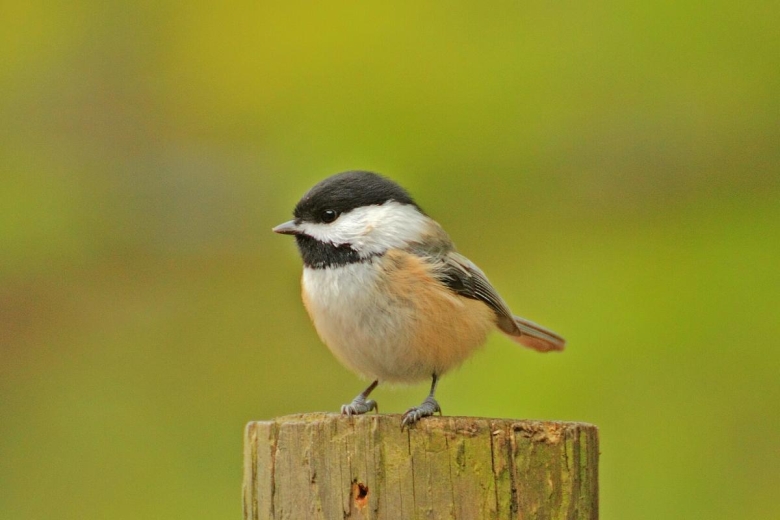
Black-capped Chickadee is native to Idaho year-round. It can only be termed as “adorable,” with its small, busty body with black and white striped wings and tail, a black head and neck, and a white strip beneath its eyes. They grow 4.7 to 5.9 inches in length and weigh 0.3 and 0.5 ounces with a wingspan between 6.3 and 8.3 inches. They inhabited open wooden areas and feed on seeds, insects, and berries. They can be lured to a backyard with sunflower seeds, suet, or peanut butter.
Western Tanager
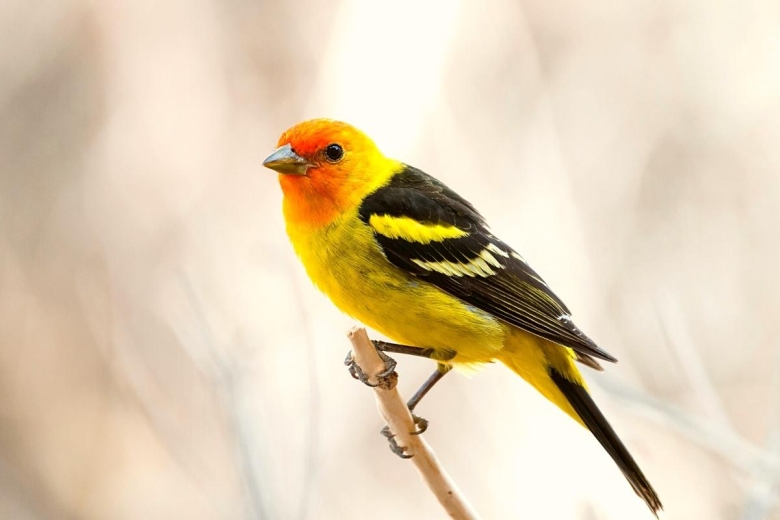
Western Tanager can be seen in Idaho mainly from May through September and surely qualifies as one of Idaho’s most colorful birds. They have a bright orange-red head that melds into a yellow belly and black-tipped yellow tail. Its wings are black with yellow markings. They grow 6.3 to 7.5 inches in length and weigh 0.8 to 1.3 ounces. They inhabit the canopies of coniferous forests, which makes them difficult to spot. The Western Tanager feeds on insects during the summer and add fruit to their winter diet.
Black Birds in Idaho
European Starling
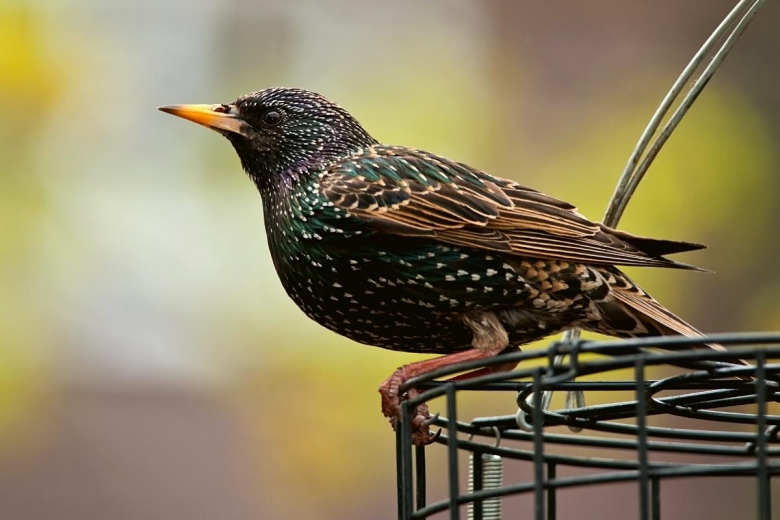
European Starling is a chunky black bird with a short tail and a long beak. They may appear all black, but in the summer, they turn an iridescent purplish-green with a yellow beak. When they shed their feathers for the winter, the wings develop noticeable white spots. They grow 7.9 to 9.1 inches in length and weigh 2.1 to 3.4 ounces with a wingspan between 12.2 and 15.8 inches. The Starling can be found in towns and the countryside where they forage through lawns, fields, and parking lots for insects, earthworms, snails, berries, and seeds.
Red-winged Blackbird
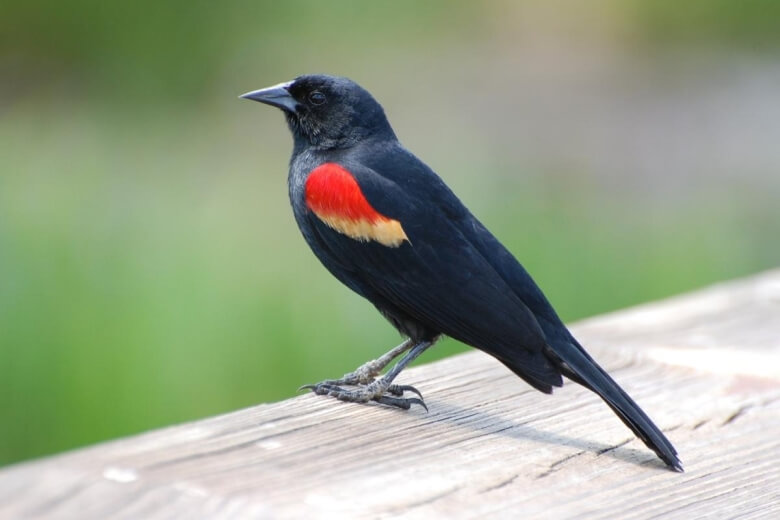
Red-winged Blackbird can be found year-round in Idaho, but most often in the summer. They are black with a red-orange emblem patch on each wing. The female is a duller brown. They grow from 6.7 to 9.1 inches in length and weigh 1.1 to 2.7 ounces with a wingspan between 12.2 and 15.8 inches. They like to inhabit wet areas, such as marches, but can also be found in meadows and fields. They feed on insects in the summer and seeds in the winter.
Common Grackle
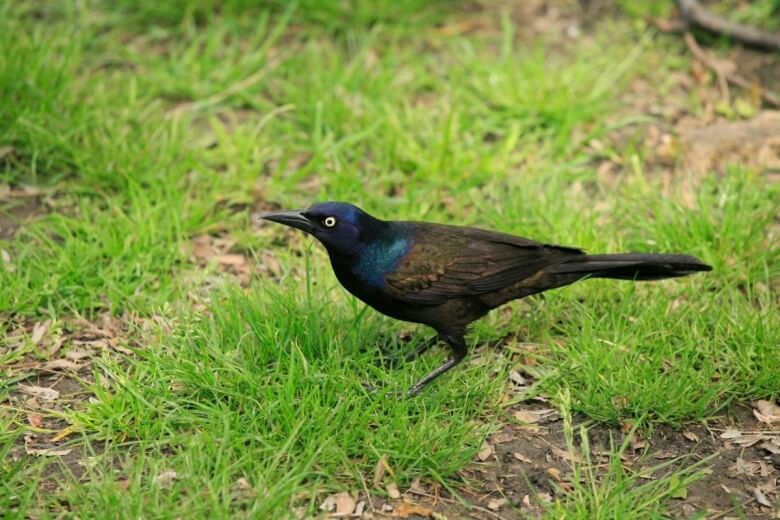
Common Grackle is found mostly in northern Idaho. They are large, with long legs and tails with a long bill. Their body is a glossy black while their head is iridescent purple, with yellow eyes that make them look very serious. The female lacks most of the male’s overall gloss. Both sexes grow 11.0 to 13.4 inches in length and weigh 2.6 to 5.0 ounces with a wingspan between 14.2 to 18.1 inches. They inhabit lawns, forest edges, and fields. Grackles eat almost anything, from mice, fish, worms, and other birds.
Blue Birds in Idaho
There are two different species of blue birds in Idaho, the Western Bluebird and the Mountain Bluebird.
Western Bluebird
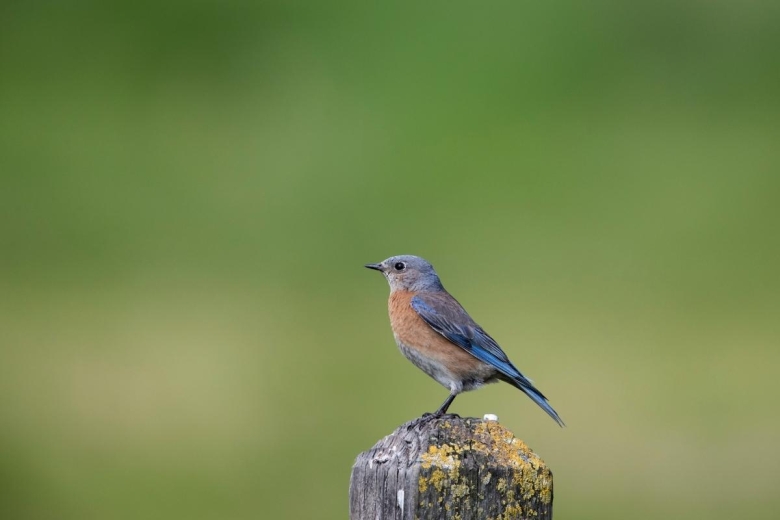
Western Bluebird can be found throughout Idaho in meadows, coniferous and deciduous forests, and mountainous regions. They are small and stocky with short tails. The male has a bright blue head and wings with orange sides and a white belly and tail. The female is more grayish with a paler shade of orange. They feed on insects and berries.
Mountain Bluebird
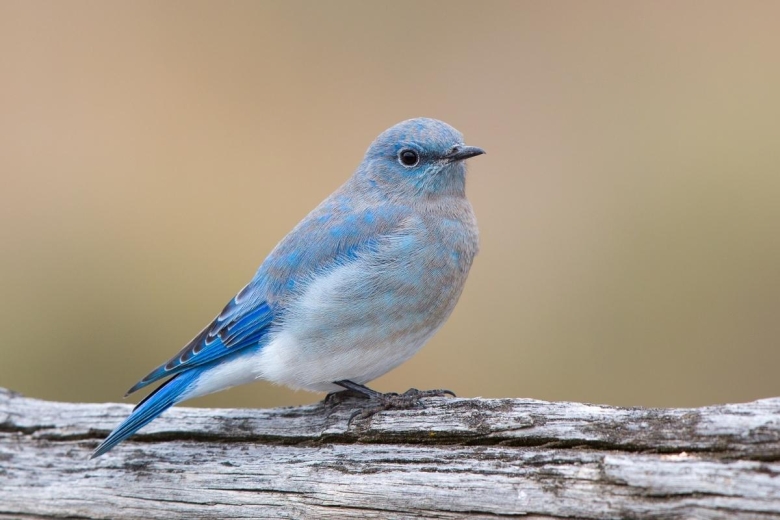
Mountain Bluebird inhabit the same areas as the Western Bluebird, but they enjoy a higher elevation of about 4,000 feet. They are fairly small. The male is entirely blue, with darker shades of blue on the wings and tail and a lighter blue on the belly. They have a black bill. Females lean toward gray shades with just a few hints of blue. They prey on insects and berries
Red Birds in Idaho
Cassin’s Finch
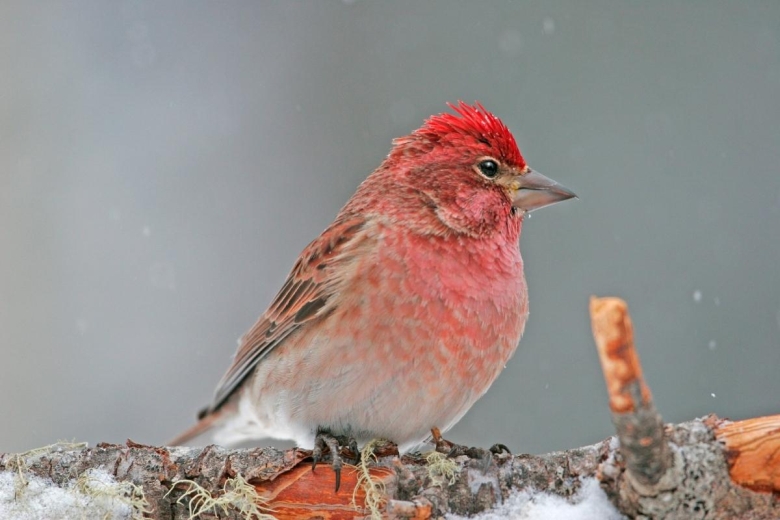
Cassin’s Finch is in Idaho all year, but they can mostly be found during their breeding season from April to September. The first impression of the male Cassin’s Finch is bashfulness due to his blush-pink throat topped by a red tuff. His wings and tails are striped black and pink, while the underbelly is white. The female has brown and white stripes. They both have heavy bills and notched tails. They grow 6.3 inches in length and weigh between 0.8 and 1.2 ounces with a wingspan between 9.8 and 10.6 inches. They inhabit mountainous areas with an elevation of 10,000 but will move lower during the winter. Most of their diet consists of quaking aspen buds, but they also eat insects and seeds.
White-winged Crossbill
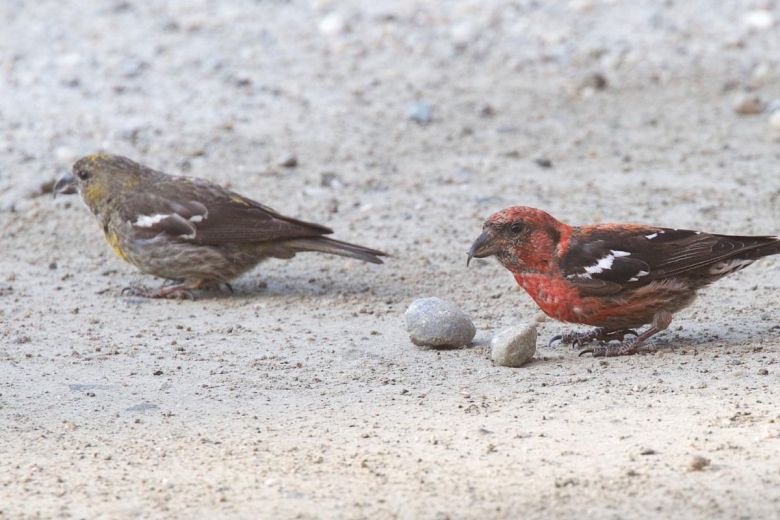
White-winged Crossbill can be found throughout Idaho. They are medium-sized with a heavy bill. The male is rosy-red with black wings that have two white bars across. The female has a more yellowish shade. They grow 5.9 to 6.7 inches in length and weigh 0.8 to 0.9 ounces with a wingspan between 10.2 and 11.0 inches. They inhabit mostly boreal forests and use their strong, crossed bill to open pinecones for their seeds.
Summer Tanager
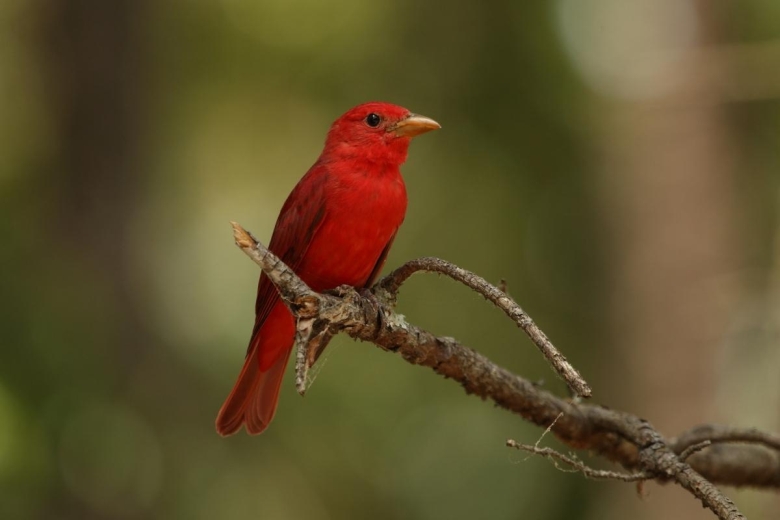
Summer Tanager can be spotted around Idaho Falls. Both the male and female are slender, medium-sized birds, but the male is entirely red, while the female yellow with hints of green. They grow 6.7 inches in length and weigh 1.1 ounces. They prefer to remain high up in the forest canopy of deciduous and pine forests and snap at insects in midair.
Orange Birds in Idaho
Bullock’s Orioles
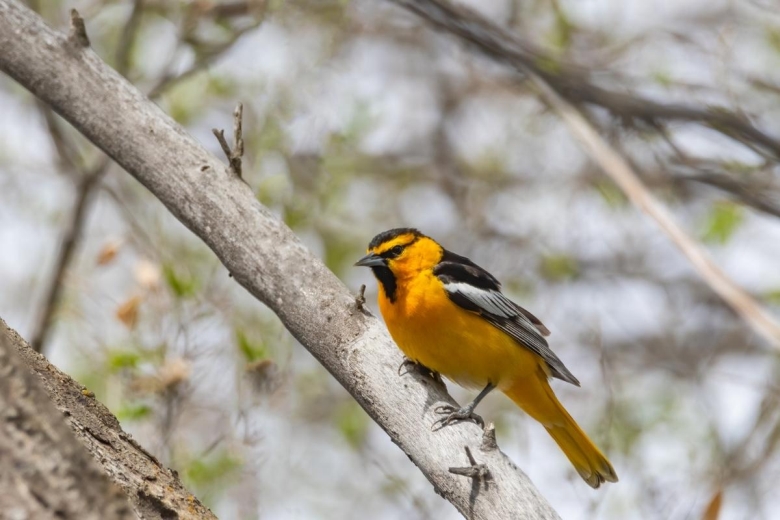
Bullock’s Orioles can be seen in the Upper Snake River Valley in the spring. By May and June, they nest close to the local lakes and rivers. The male is a vivid orange with a black back and black and white striped wings and tail. He is noticeable for the black lines running through the eye and the black throat. Females are pale orange. They inhabit open woodlands, orchards, and parks where they feed on caterpillars and fruit nectar.
Spotted Towhee
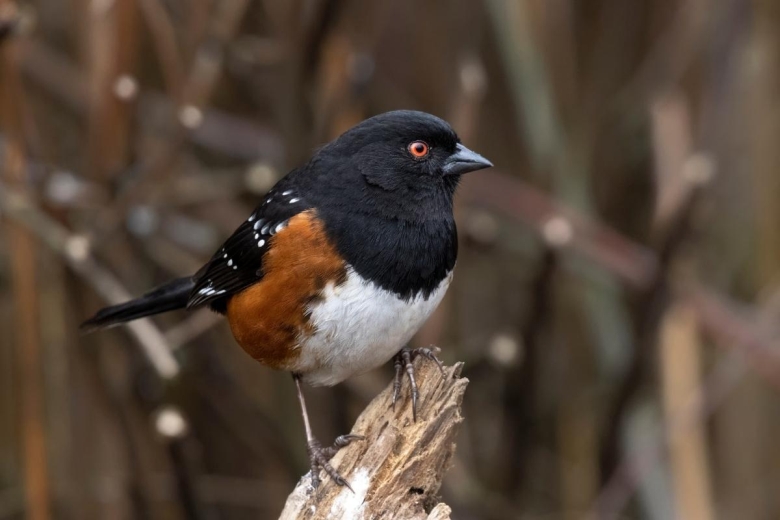
Spotted Towhee can be seen in Idaho during the breeding season from March to September. They are a chunky bird with long, rounded tail and a thick bill. The male has a black upper part with black wings that are dotted with white and rusty-orange sides. The female is gray instead of black. They grow 6.7 to 8.3 inches in length and weigh 1.2 to 1.7 ounces with a wingspan of 11 inches. The Spotted Towhee inhabits shrubby areas with heavy undergrowth, forest edges, and fields, where they forage for insects and seeds.
Varied Trush
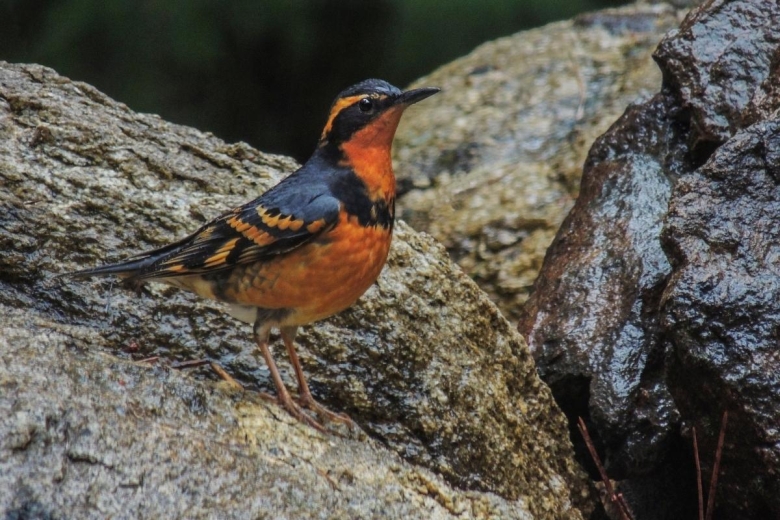
Varied Trush can be spotted in East Idaho during the summer. It is stocky with a round head and long legs. With its coloring, this lovely thrush was meant for Halloween. The blue back is offset by a rusty orange throat and a lighter orange underbelly. The wings are black with orange bars. The female is a paler version of the male. Both sexes grow 7.5 to 10.2 inches in length and weigh 2.3 to 3.5 ounces with a wingspan between 13.4 to 15.0 inches. They inhabit mixed forests and feed on insects and arthropods.
Yellow Birds in Idaho
Nashville Warbler
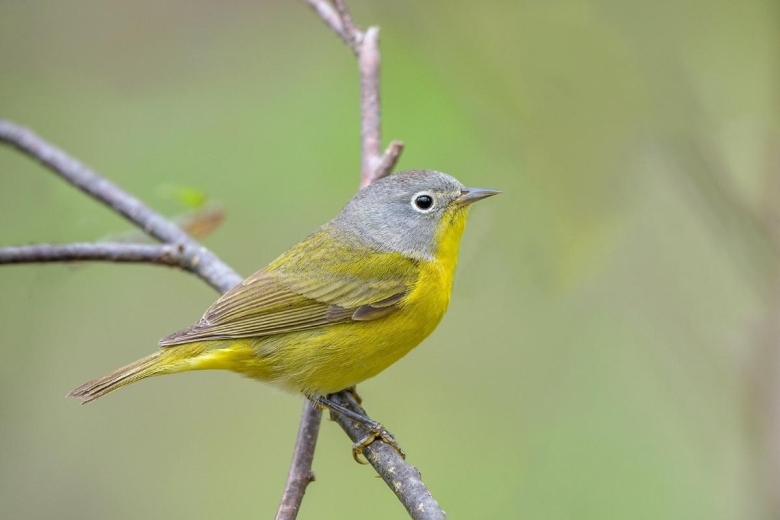
Nashville Warbler spends the months of April to September in Idaho. This warbler is a small, plump bird with a round head and a black and yellow short tail. Everything about it seems small and delicate. It has a light green back, and bright yellow underbelly that turns white, and a yellow rump. The wings are gray and yellow striped, while the head is totally gray with a little red spot on top. As is frequently the case, the female is a duller version of the male. They inhabit shrubby areas and mixed forests where they feed mostly on insects.
Eastern Meadowlark
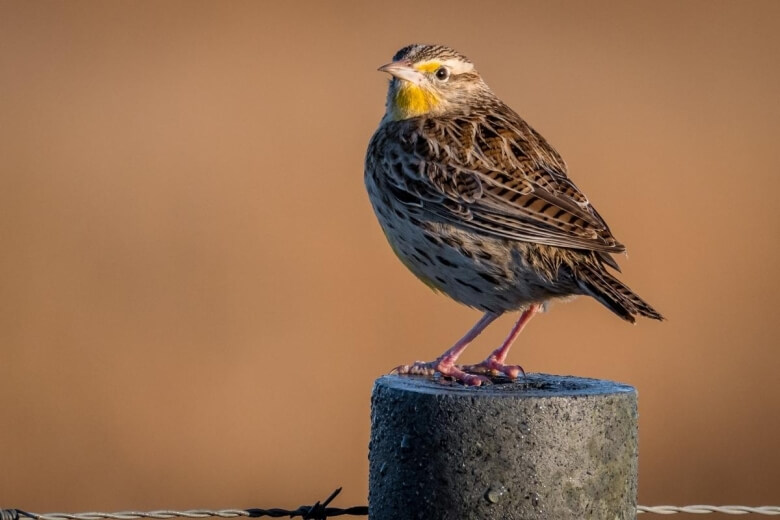
Eastern Meadowlark can be found in Idaho throughout the year. It is a chunky, short-tailed bird with a long, thin bill. Its underbelly is yellow while the upper parts are a pattern of tan, brown, and black. There is a noticeable black V mark on the breast. It also has black stripes down its eyes and gray head. They grow 6.3 to 10.2 inches in length and weigh 3.1 to 4.1 ounces with a wingspan of 16.1 inches. They inhabit grasslands and fields with medium-tall grass where they forage for insects and seeds and add grain to their winter diet.
American Goldfinch

American Goldfinch spend time in north and south Idaho. They are small with long wings, a short tail, and a conical bill. They growth 4.3 to 5.1 inches in length and weigh 0.4 to 0.7 ounces with a wingspan between 7.5 to 8.7 inches. The male is a vivid canary-yellow with a black forehead and black wings that have white markings. There are white patches around the tail, as well. The female is a duller shade of yellow. They inhabit farms, woodlands, and urban areas, basically anywhere they can find their favorite thistles and asters.
Common Bird Species in Idaho
Warblers in Idaho
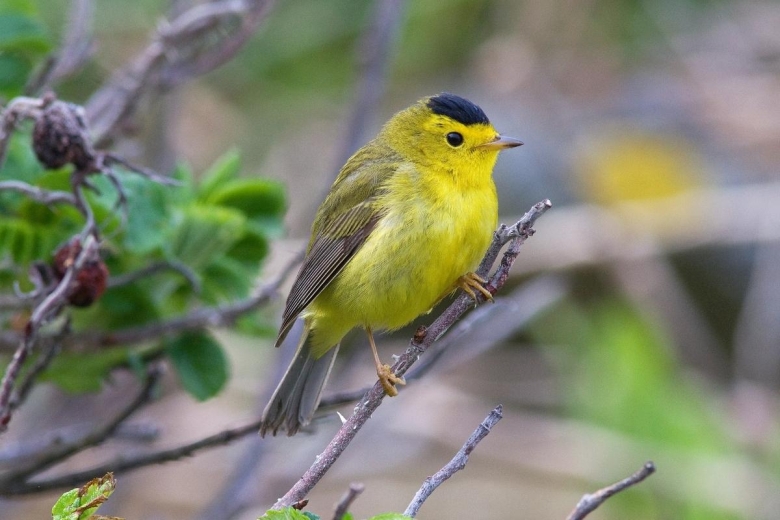
Wilson’s Warblers – Cardellina pusilla – can be seen during their spring and fall migrations, although some do remain in north Idaho. They are small with a long tail and a thin bill. Both the male and female are olive above with a vivid yellow underside. They have large, black eyes, with the male sporting a black cap on top of his head; the female has a smaller cap. They grow to 3.9 to 4.7 inches in length and weigh 0.2 to 0.3 ounces with a wingspan between 5.5 to 6.7 inches. They live in mountainous areas near streams or lakes and forage for insects in the underbrush.
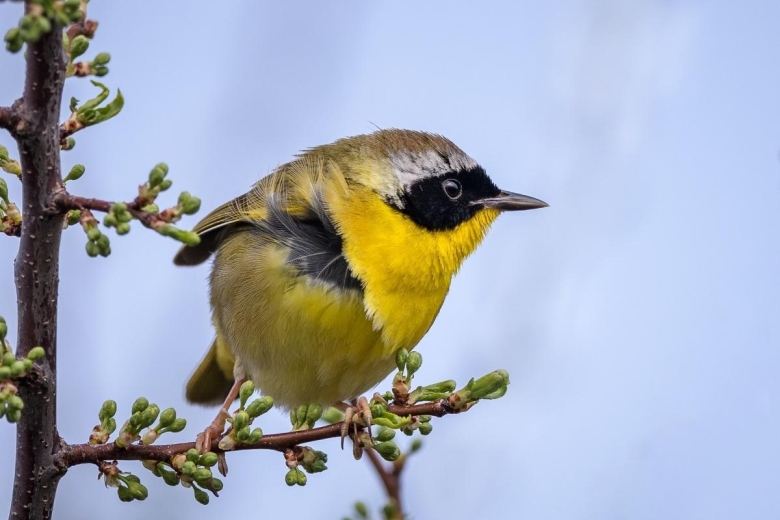
Common Yellowthroats – Geothlypis trichas – come to Idaho to breed from May to September. They are small, and chunky with a rounded tail. The male has a yellow underbelly and olive wings. He has a distinctive black mask beneath white eyebrows which gives him the appearance of a mischievous highway robber. The female is more olive-colored with some yellow at the throat and rump. She does not have a face mask. The Common Yellowthroats live in open grasslands or forests and forage the ground for insects and spiders.

Black-throated Gray Warblers – Setophaga nigrescens – can be found in the southern part of Idaho during May and September. They grow 4.3 to 5.1 inches in length and weigh 3 ounces with a wingspan between 7.5 and 7.8 inches. The Black-throated Gray Warbler is a lovely black, white, and gray abstract design – as if created by Picasso during a “gray period.” The male has a gray and white striped upper body and a white and black striped underbelly. The entire face has black and white bands, with a yellow dot on top. The female is mostly similar, with lighter shades of gray and black stripes on the belly. They inhabit coniferous forests and pluck trees for insects.
Hawks in Idaho

Northern Harrier – Circus hudsonius – lives in Idaho all year but prefers the open areas of the southern part of the state. This is a medium-sized predator with long wings and a hooked bill. They grow 18.1 to 19.7 inches in length and weigh 10.6 to 26.5 ounces with a wingspan between 40.2 to 46.5 inches. The male is gray and white striped above with black bands in the wings and tail. The female is browner. They inhabit open areas such as fields and marches where they stalk small animals.
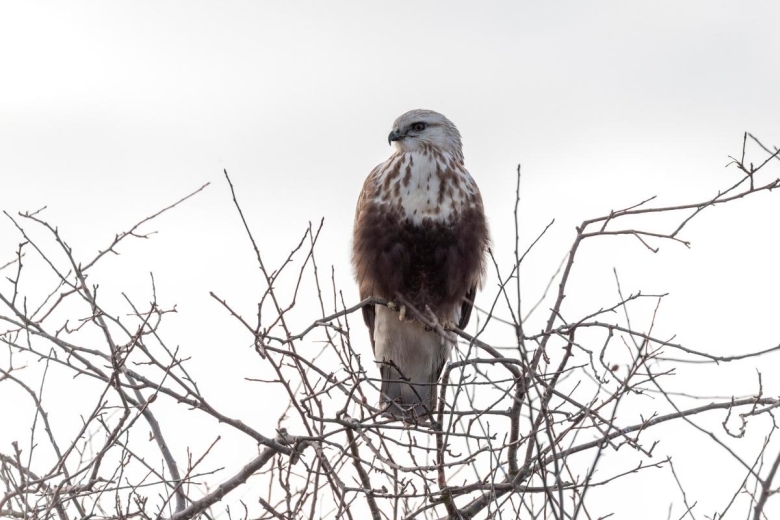
Rough-legged Hawk – Buteo lagopus – can be seen in the winter during their migration. This is a large hawk with wide wings and a long tail. They grow 18.5 to 20.5 in length and weigh 25.2 to 49.4 ounces with a wingspan between 52.0 to 54.3 inches. Both the wings and tails have dark bands. The underside of the wings is a mottled white while the upper wings are brown. The belly, back, and neck are a mottled brown. The female is a few shades paler. They get their name from their feathered legs and are one of only a few birds with that anomaly. They feed on small rodents, and in the winter, they hunt mice, shrews, and moles.

Northern Goshawk – Accipiter gentilis – can be found in Idaho in the Sawtooth National Forest and the Peregrine Fund’s World Center for Birds of Prey in Boise. These are large hawks with broad wings and long tails. They are a deep gray above and a paler gray underneath. They have white circles around their red eyes. The female is browner and larger than the male.
They grow 20.9 to 25.2 inches in length and weigh 22.3 to 48.1 ounces with a wingspan between 405 to 46.1 inches. Females are larger than males. The Goshawks are fierce predators and hunt through coniferous forests for other birds, squirrels, hares, and rabbits.
Egrets in Idaho
Any water site in Idaho is likely to have one or more egret species. They are known for wading through shallow waters in search of food.

Great Blue Heron – Ardea Herodias – can be found around Idaho’s wetlands, rivers, and lakes. They are usually very motionless and quiet as they search for their prey in the water. These herons have exceptionally long legs, an “S” shaped neck and a long, thick yellow bill that they use to stab at their prey. Both sexes grow 38.2 to 53.9 inches in length and weigh 74.1 to 88.2 ounces with a wingspan between 65.8 and 79.1 inches. They are gray-blue with dark bands at the end of their wings. Their face is white with a blue stripe running down the middle. They feed on fish, small mammals, frogs, and other birds.
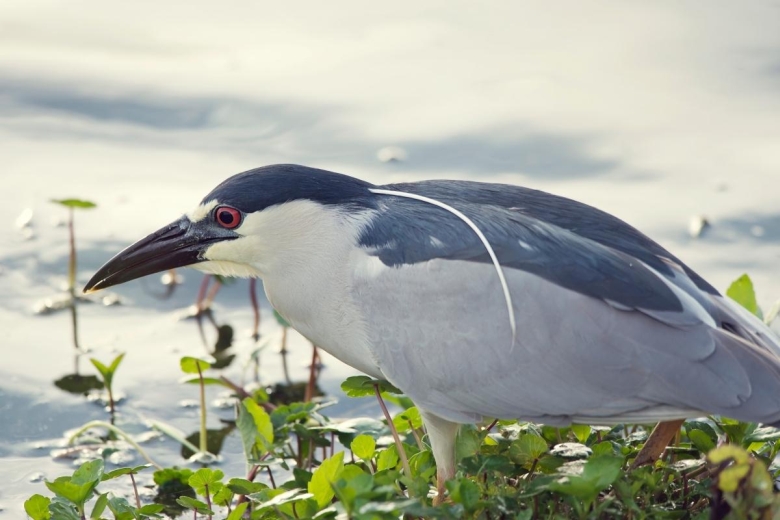
Black-crowned Night-Heron – Nycticorax nycticorax – are a common sight throughout Idaho’s wetlands. However, they usually hide during the day and don’t come out until after dusk, so it can be a challenge to spot them. They are smaller and chunkier than most herons, with thick necks and heavy bills. Their legs are short. Both sexes grow 22.8 to 26.0 inches in length and weigh 25.6 to 35.8 ounces with a wingspan between 45.3 and 46.5 inches. Adults have light-gray wings and blue heads and beaks (rarely black, as the name may imply) with an all-white underbelly. Like other egrets, they inhabit areas near marshes, lakes, and streams and feed on fish, crustaceans, frogs, clams, mussels, and the eggs of other birds.

Snowy Egret – Egretta thula – Snowy Egrets spend the breeding season in Idaho and are spotted from April to October. True to their name, they are snowy white herons with long black legs and a long black bill. Their neck is also long – this is very much a vertical bird. Their large feet are a noticeable yellow, and there is a small yellow patch below the bill. They grow 22.1 to 26.0 inches in length and weigh 13.1 ounces. They are most common in shallow coastal waters or wetlands, anywhere they can spear the fish that is their food.
Further Reading on Birding in Idaho
For more information on birding in Idaho, consider the following books:
- Tekiela, Stan (Author)
- English (Publication Language)
Birders can also check the following sources for more information:


